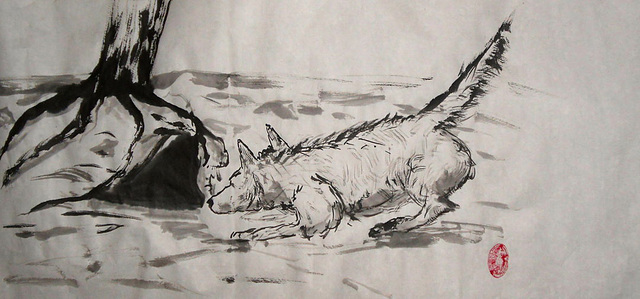Tuesday's doodle 2
passing season
円 , まる, Maru: Round
De legende van de Witte Wieven
Cock Fight
2014
Cow Satori
Possible new U.S. Forest Service mascot from down…
sun chaser
酒仙の猫
鼠 と 猫 (nezumi to neko)
Years apart
In the high pasture
Death and Destruction
and the three bears
2018
早い; hayai (Quick)
OnGuard
Zen and the art of bull sitting
Karate Hog, Also knows as the Pork Chop Pig
Life's Good
衛兵 sentinel
PandAmonium
Paint a purple pony
The Owl and the Pussycat went to see
Skyborn
lunch time
Daruma greets 2011
un-coy Koi
early
Audrey
Afternoon nap on Miyajima, Seato Inland Sea
竜, たつ, tatsu, dragon
枝の鳥は月にウサギを見て...
After Hakuin Ekaku
Friday morning doodle
卯年 usagidoshi
Come on!
Keywords
Authorizations, license
-
Visible by: Everyone -
All rights reserved
-
183 visits
Curious


While I was painting the 'Returning', I wanted to take a closer look at the wolf, hence this sumi-e. This wolf is younger than the one in 'Returning' , the shortness of his body suggests a juvenile, and he is brim full of curiosity!
The hanko, (the red stamp,in the lower right that I used to sign this work) was carved for me by Oka Isso in Japan, at the request of a good friend of mine. The hanko is a styilized version of the kanji, the word , zoku, written in kanji it's 俗, or written in hiragna it's ぞく.
In her stylized version of 俗 (zoku) Okasan sees the first half of the kanji, 人 (pronounced to, thats a long 'o' not a 'yu' sounds, more like toe), which means person, she sees as a bird rising. The second half, 谷 (tani), meaning valley, she represented by the lines below and to the right and left of the bird.
俗 (zoku): Okasan says that it, in English, means local manners or folkways. Personally there is another meaning for the kanji that I like better: It also means just a common man.
Since the hanko (Oh yea, as I gave the Japanese "spelling" of the other words, I guess I should also include the kanji and hiragana for 'hanko': 判子, はんこ.) is hand carved, each hanko is unique and, subsequently used as a signature.
There is still another meaning of the kanji, 俗 (zoku), that I like best; it can also mean vulgar. However, alas, neither my friend, Tomochan, nor the hanko carver, Okasan, feel that 'vulgar' is a suitable word for me to use as my signature on my sumi-e. :-)
By the way; to see the kanji I included above, you need to have a Japanese font on your computer. If instead of seeing a kanji here, such as 松山市 (which means Matsuyama City) you see something like: æ°´æ>oæ-¥ã??, -that means you do not have the Japanese font installed.
Back to the picture: sumi-e, brushed ink on 'rice' paper, unmounted, 13 by 26 inches.
The hanko, (the red stamp,in the lower right that I used to sign this work) was carved for me by Oka Isso in Japan, at the request of a good friend of mine. The hanko is a styilized version of the kanji, the word , zoku, written in kanji it's 俗, or written in hiragna it's ぞく.
In her stylized version of 俗 (zoku) Okasan sees the first half of the kanji, 人 (pronounced to, thats a long 'o' not a 'yu' sounds, more like toe), which means person, she sees as a bird rising. The second half, 谷 (tani), meaning valley, she represented by the lines below and to the right and left of the bird.
俗 (zoku): Okasan says that it, in English, means local manners or folkways. Personally there is another meaning for the kanji that I like better: It also means just a common man.
Since the hanko (Oh yea, as I gave the Japanese "spelling" of the other words, I guess I should also include the kanji and hiragana for 'hanko': 判子, はんこ.) is hand carved, each hanko is unique and, subsequently used as a signature.
There is still another meaning of the kanji, 俗 (zoku), that I like best; it can also mean vulgar. However, alas, neither my friend, Tomochan, nor the hanko carver, Okasan, feel that 'vulgar' is a suitable word for me to use as my signature on my sumi-e. :-)
By the way; to see the kanji I included above, you need to have a Japanese font on your computer. If instead of seeing a kanji here, such as 松山市 (which means Matsuyama City) you see something like: æ°´æ>oæ-¥ã??, -that means you do not have the Japanese font installed.
Back to the picture: sumi-e, brushed ink on 'rice' paper, unmounted, 13 by 26 inches.
- Keyboard shortcuts:
Jump to top
RSS feed- Latest comments - Subscribe to the comment feeds of this photo
- ipernity © 2007-2025
- Help & Contact
|
Club news
|
About ipernity
|
History |
ipernity Club & Prices |
Guide of good conduct
Donate | Group guidelines | Privacy policy | Terms of use | Statutes | In memoria -
Facebook
Twitter

Sign-in to write a comment.